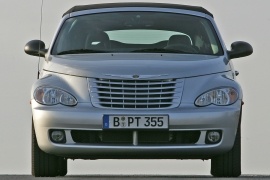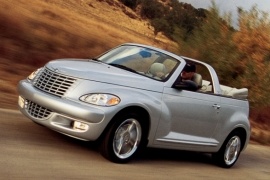CHRYSLER PT Cruiser Convertible Models/Series Timeline, Specifications & Photos
First production year: 2004
Engines: Gasoline
Body style: Convertible (spider/spyder, cabrio/cabriolet, drop/open/soft top)
Chrysler introduced a mid-life cycle refresh for the PT Cruiser and the PT Cruiser Convertible in 2006.
It was a bad time for the worldwide car industry, but no one knew that, yet, in 2006 when the facelift was introduced to the market. Those were times for blooming. The global economy looked well, but everything crashed in 2007, along with the world financial crisis that brought more carmakers to the brink of bankruptcy, and car models were wiped out from the assembly lines.
The facelifted version of the PT Cruiser convertible sported a new front fascia design with a double-arched lower line for the headlights. It resembled the same cues as some Mercedes-Benz models. In those times, worth mention it, it was Daimler-Chrysler, a marriage that lasted less than anyone imagined. Its wider fenders, both front, and rear were kept since they made a good impression on the market thanks to the vehicle's overall retro-design look.
Inside, the three-dials design sported two gauges on the left, the speedometer in the middle, and the tachometer on the right. Depending on the option, the PT Cruiser Convertible featured a radio-cassette player or a CD-Player sold as a premium sound system. The design team couldn't find a better solution for the rag-top when it was retracted, and it was still left behind the rear seats, exposed to the air.
Depending on the market, Chrysler offered the PT Cruiser with a choice of gasoline or diesel engines. The European customers preferred the latter. For the U.S. market, the carmaker provided a 2.4-liter inline-four engine with or without a turbocharger.
The PT Cruiser was initially launched in 2001, and customers queued in front of dealers' showrooms to grab one. That led to an increase in prices way above the MSRPs.
But the PT Cruiser frenzy was far from over, and Chrysler noticed an increasing interest in an open-top version. Thus, in 2004, it launched the Convertible.
While the front fascia was clearly carried over from the hatchback version, with tear-shaped headlights and a V-shaped grille that resembled cars from the '40s, the PT Cruiser convertible showed a different styling from the A-pillars to the back of the vehicle. Yes, it still had those flamboyant fenders, but it only sported two doors. To increase the car's structural rigidity, the carmaker added a C-pillar with a roll-over bar. Yet, the back of the vehicle featured the same rear-end styling of its hatchback sibling, albeit with a different trunk lid. Last but not least, the canvas top didn't completely fold and remained exposed behind the rear bench, like in the convertibles from the '40s.
But Chrysler's designers looked like they spent too much time creating the exterior and made the cabin at the last minute. Thus, they didn't have the time to put high-quality materials inside. Moreover, the bean counters insisted that the car had to be affordable so the automaker could sell it to rental companies. So even if the GT trim level featured leather seats, the hard plastic parts from the rest of the cabin spoiled the haute-couture look of the car.
Under the hood, Chrysler installed the same inline-four powerplants available for the Neon range and paired them with either a five-speed manual or a four-speed automatic.

